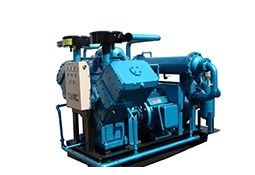Sales Department: 0552-3825188 0552-3825333
Accessories Department: 15955260712
Company Fax: 0552-3825255, 3825200
CNG Department: 13865028777 13865066118
After-sales service: 0552-3825155 0552-3825156
Company Address: No. 2581, Shuangdun Road, Huaishang District, Bengbu, Anhui Province
Company email: zdysj@126.com ahzdysj@126.com
How to adjust the air volume of the air compressor?
The actual working conditions of the air compressor vary with the needs of the process flow or gas equipment, and it is not suitable to select the air compressor according to the larger volumetric flow required by the device or system. When the air consumption is less than the air compressor displacement, the air compressor displacement needs to be adjusted to meet the air consumption requirements and keep the pressure in the pipe network stable.
The following introduces the commonly used air volume adjustment methods of air compressors:
1. Press open the intake valve to adjust.
This method classifies full-stroke pressure intake valves and partial-stroke pressure intake valves according to the length of the intake valve being pressed in. Regarding the adjustment of the full-stroke pressure intake valve, during the intake process, the gas is sucked into the cylinder. During the compression process, the intake valve is completely opened, and the inhaled gas is completely pushed out of the cylinder. Assume that the air compressor has a single-stage double-acting cylinder. If only the intake valve on one side of the piston is pushed up, the air volume will be reduced by 50%, and if both sides are pushed up at the same time, the air volume will be zero. Therefore, the compressor can achieve three-stage air volume adjustment. It can be seen that the full-stroke pressure inlet valve has a large adjustment range and is suitable for coarse adjustment. The adjustment principle of the partial-stroke pressure intake valve is similar to that of the full-stroke pressure intake valve, but the return air volume is controlled by controlling the closing time of the intake valve during the operation of the air compressor, so as to achieve continuous adjustment of the air volume. Since the compression work decreases almost in proportion to the displacement, it also has a higher operating economy.
2. Speed adjustment.
Speed adjustment is to adjust the displacement by changing the speed of the air compressor. The advantage of this kind of adjustment is that the air volume is continuous, the specific power consumption is low, the pressure ratio of each stage of the air compressor is constant, and no special adjustment mechanism is required on the air compressor. However, it is only widely used to drive air compressors for internal combustion engines and steam turbines. If the driving machine is a motor, a frequency converter is required. Because high-power and high-voltage frequency converters are expensive and require a lot of maintenance and repair work, this method is rarely used for motor-driven reciprocating air compressors. In addition, variable speed adjustment may adversely affect the operation of the air compressor, such as valve flutter, large parts wear, increased vibration, insufficient lubrication, etc., which also limits the wide application of this method.
3. Bypass adjustment.
The exhaust pipe is connected to the intake pipe through a bypass pipe and a bypass valve. When adjusting, only the bypass valve is opened, and part of the exhaust gas will return to the intake pipe. This adjustment method is flexible, simple, and easy to implement, and the adjustment accuracy of the automatic control system is relatively high. However, because the compression work of the excess gas is completely lost, the economy is poor. Therefore, this method is suitable for occasional adjustment or occasions where the adjustment range is small.
4. Adjust the clearance cavity.
Except for the fixed clearance volume, there is no certain cavity on the cylinder of the air compressor. It is connected with the working chamber of the cylinder during adjustment, which increases the clearance volume, reduces the volume coefficient and reduces the displacement. This is the working principle of gap cavity adjustment. According to the different access methods of the subsidy amount, it is divided into continuous and intermittent access hierarchical adjustments, which are mostly used for large-scale process air compressors. The main disadvantage of this adjustment method is that it is usually manually adjusted, the response speed is slow, and it needs to be used in conjunction with other adjustment methods. Although the connection mode of the variable margin gap volume can be adjusted within a controllable range in principle, the system has poor reliability, many vulnerable parts, and difficult maintenance.

Previous: The status quo and development trend of compressor technology
下一条: No Information
Related News
- The status quo and development trend of compressor technology
- Knowledge about daily maintenance of air compressors
- Reasons for lack of compressor displacement
- What are the common faults of compressors?
- Maintenance of natural gas compressor
- Safe use of vinyl chloride compressors
- Analysis of several common failures of dimethyl ether compressor
- The structure and characteristics of vinyl chloride compressor
- How to maintain the vinyl chloride compressor?
- About the composition and price calculation of nitrogen compressor



